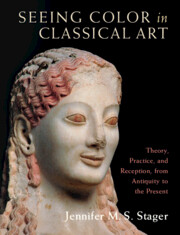Book contents
- Seeing Color in Classical Art
- Seeing Color in Classical Art
- Copyright page
- Dedication
- Contents
- Acknowledgements
- Introduction
- Chapter 1 Material Color, Language, and Khrōma
- Chapter 2 Additive Colors, Kosmēsis, and Care
- Chapter 3 Khōra, Relief, AND Landscape
- Chapter 4 Inlaid Eyes, Effluences, and Opsis
- Chapter 5 Atoms, Lithoi, and Animacy
- Epilogue
- Select Bibliography
- Index
Epilogue
Published online by Cambridge University Press: 25 November 2022
- Seeing Color in Classical Art
- Seeing Color in Classical Art
- Copyright page
- Dedication
- Contents
- Acknowledgements
- Introduction
- Chapter 1 Material Color, Language, and Khrōma
- Chapter 2 Additive Colors, Kosmēsis, and Care
- Chapter 3 Khōra, Relief, AND Landscape
- Chapter 4 Inlaid Eyes, Effluences, and Opsis
- Chapter 5 Atoms, Lithoi, and Animacy
- Epilogue
- Select Bibliography
- Index
Summary
The opening ceremony for the 2004 Olympic Games took place not at Olympia, the ancient site in the Peloponnese region of mainland Greece that gave its name to the modern games, but, like the first modern games of 1896, in Athens, the capital of the modern nation-state of Greece. This slippage between places maps an ancient artistic connection forged by two colossal polychrome statues, the Athena Parthenos in Athens and the seated Zeus at Olympia, both designed and produced by Pheidias and artists of his workshop. Neither statue exists today; because of their vibrant splendor, politicians spent, people reused, and time degraded the gold, ivory, wood, jewels, stones, and added pigments that formed them. Elements of both statues, however, persist in reproductions, descriptions, and reconstructions. Pausanias, for example, provides a vivid description of their appearance in the second century ce. In conjunction with other literary references and archaeological and epigraphic evidence, we can today form an idea of how these statues might once have been pieced together and beheld.
Information
- Type
- Chapter
- Information
- Seeing Color in Classical ArtTheory, Practice, and Reception, from Antiquity to the Present, pp. 273 - 292Publisher: Cambridge University PressPrint publication year: 2022
